Original source: http://www.bbc.co.uk/sport/rugby-union/56933494
Friday, April 30, 2021
Women's Six Nations: England's Poppy Cleall wins Player of the Championship award
Coach’s Corner Issue 10: How loose can you be?
Thanks once again to all who either contributed a question, or debated one in this week’s callout. Watching a query as it is refined through discussion can be especially helpful to my responses on Friday.
Is it just me or does it appear that our most consistent forwards in terms of total contribution are weighted to Force, Rebels and Brumbies? Waratahs and Reds both seem a bit short of impact?
– Noodles
Statistically, who are the most effective loose forwards in Super Rugby AU and Super Rugby Aotearoa?
– KiwiHaydn
What do you think of the role of playing flankers or number eight in the second row? Last week Rob Leota, Angus Scott-Young and Hugh Sinclair were all in the second row. These players are generally around 190cms. Do you see this working in international rugby?
– Take the Points
These questions are all related to one another, directly or indirectly. As the game gets faster and the ball-in-play time increases, one of the spots coaches tend to look at for an increase in overall team speed is the second row. There has been something of a boom in players who can operate equally effectively in the last two rows of the scrum.
Some of the best big men in the UK and Ireland can handle both number six and second row efficiently – Maro Itoje and Courtney Lawes in England, Tadhg Beirne and Iain Henderson in Ireland, Bernard le Roux in France. Even Alun-Wyn Jones started out as a blindside flanker before deciding his best position was going to be one row ahead in the pros.
If all five of those players were fully fit, they would be on the plane to South Africa with the Lions in a couple of months. There, they will lock horns with the best of breed on the planet in the shape of Pieter-Steph du Toit. In order for these players to succeed at Test level, as a general rule they have to be 195 centimetres plus.
The meat of the question is a comparison of the productivity of the loose forwards in Super Rugby. I’ll leave Super Rugby Aotearoa to a separate column and focus instead on AU.
Here is a table containing the stats for the top loose forwards in Australia. I’ve used 450 minutes of play as the baseline for inclusion. There are also two forwards – Tim Anstee and Lachie Swinton – who have not racked up the minutes, but are clearly players of national interest.
First, the attacking stats.
| Minutes between carries | + or – impacts | Decisive outcomes (breaks or try assists) | Lineouts won | |
|---|---|---|---|---|
| Harry Wilson | 7.1 | +3 | 0 | 5 |
| Pete Samu | 14.7 | +3 | 8 | 9* |
| Brynard Stander | 8.3 | +8 | 1 | 4 |
| Michael Wells | 14.2 | +9 | 4 | 17 |
| Angus Scott-Young | 11.5 | +3 | 0 | 17 |
| Rob Valetini | 10.3 | +11 | 4 | 2 |
| Tim Anstee | 8.2 | +2 | 5 | 16 |
| Lachie Swinton | 8.6 | +5 | 0 | 14 |
| Josh Kemeny | 10.5 | +8 | 1 | 5 |
| Fraser McReight | 9.8 | +14 | 10 | 1 |
| Kane Koteka | 12.1 | +12 | 3 | 1 |
| Richard Hardwick | 14.5 | +3 | 3 | 0 |
| Carlo Tizzano | 9.2 | +7 | 2 | 0 |
*includes steal
‘Minutes between carries’ is a guide to work-rate on attack, while the ‘Impacts’ (gain-line wins) and ‘Decisive outcomes’ columns are measures of success. Lineout is obviously another key stat for the bigger men at numbers six and eight.
Harry Wilson has a huge work rate (more than twice the frequency of carries compared to Pete Samu, for example), but he has really struggled to make an impact in 2021.
Wilson and Samu offer two contrasting interpretations of the number eight’s role: Wilson an inside power runner and ground-gainer, Samu operating in the wide channels as a strike runner and game-breaker.
Rob Valetini is by far the most dominant number six on the gain-line, while Tim Anstee holds out the promise of being able to fill the Samu-type role at lineout and wider out in attack.
Fraser McReight is obviously the outstanding number seven playing in Australia, and the relative lack of success of Wilson and Angus Scott-Young on the gain-line at the Reds has not inhibited his orbit of influence as an attacker.
Here are the stats for defence.
| Mins between tackles | Tackle completion | Discipline/turnovers (inc. pens conceded) | |
|---|---|---|---|
| Harry Wilson | 7.2 | 88% | -9 |
| Pete Samu | 9.3 | 87% | -6 |
| Brynard Stander | 7.2 | 81% | -2 |
| Michael Wells | 9.6 | 92% | -10 |
| Angus Scott-Young | 6.9 | 91% | -9 |
| Rob Valetini | 7.8 | 92% | -3 |
| Tim Anstee | 6.3 | 89% | -3 |
| Lachie Swinton | 4.9 | 88% | -8 |
| Josh Kemeny | 6.9 | 96% | -5 |
| Fraser McReight | 6.6 | 94% | -2 |
| Kane Koteka | 5.6 | 86% | -9 |
| Richard Hardwick | 8.4 | 83% | 0 |
| Carlo Tizzano | 4.1 | 90% | -7 |
‘Minutes between tackles’ is used to represent work rate on defence, while the ‘Discipline/turnovers’ column weighs turnovers won against those given up and the penalties conceded by the same player. A figure close to zero is an excellent outcome.
The immense tackle work rates for both Swinton and Carlo Tizzano (both sub-five-minute tackle intervals) illustrate how little possession the Waratahs were able to win and maintain this season. Swinton’s discipline and his defence of the ball on the carry remains a concern, as his minus-eight was derived from only 350 minutes of play.
McReight’s numbers are just as outstanding on defence as they are in attack. He made 11 turnovers while only giving up six penalties at the defensive breakdown, and maintaining a tackle percentage in the mid-90s.
The number of involvements by Harry Wilson is again very impressive, but there is the same lack of impact or quality. There is a sense Wilson is undergoing a plateau in his pro career, and urgently needs the support of another number eight of a similar type – like Isi Naisarani – in the Wallabies.
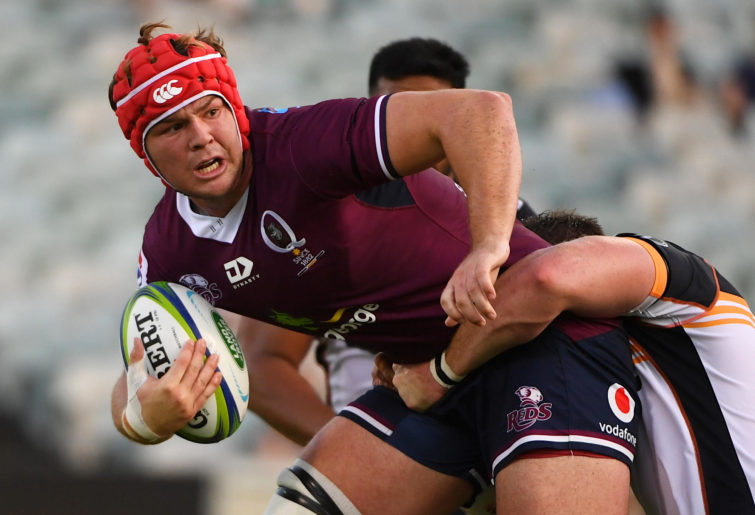
Harry Wilson. (Photo by Tracey Nearmy/Getty Images)
Watching the Waratahs’ centre pairing over the past few weeks has been at least one bright spot for the team. How do we unlock their potential better? Do you see any Wallabies game time for Izaia Perese or Lalakai Foketi?
– Stin
After a false start, Izaia Perese has arguably been the Tahs’ best attacker and he appears strong on defence, but is his defensive positioning good enough to make him a Wallabies contender?
– Hazel Nutt
Will Izaia Perese be the only backline representative from New South Wales in Dave Rennie’s match-day squad? I’m thinking Perese may get some time, he breaks nearly every tackle one on one and can also play on the wing.
– Take the Points
There does seem to be a difference in the quality of Perese’s involvements on attack and in defence. He can be a lethal offloader in the wide channels:
Two different types of offload executed perfectly – right-arm underhand to Mark Nawaqanitawase in the first example, out of the back of the hand to Jack Maddocks in the second. Perese ensures that the last defender is committed before delivering the pass.
So far, so good.
Things did not look as proficient on defence against the Force, however.
In the first example, the Waratahs have the numbers out wide, but Perese loses Tevita Kuridrani to a simple cut off his right foot – he has to remain connected to the forward inside and protect him. Later in the same sequence, his side of the defence was again beaten on equal numbers.
Perese’s tendency to sit off and let play develop in front of him creates a lot of difficulties for the men around him:

That means a lot of work for the defence coach Matt Taylor if Perese gets the call to Camp Wallabies.

Izaia Perese. (Photo by Jono Searle/Getty Images)
Some tighthead props bind low on the hooker’s shorts instead of up across the shoulder. Physics of this bind angles his body inwards and thereby concentrating the drive energy towards the hooker. Why do they do this? Is it to concentrate more energy on the hooker and force the scrum inwards or, is it a counter move to stop the hooker coming through that space?
– Wayne
If you watch the front rows set up for a scrum, you’ll notice the loosehead and hooker binding up tight first, in the region between chest and shoulders. The better tightheads will enter as the last man and look to bind as low on their hooker’s shorts as possible with their left arm.
Why? Because it gives them maximum flexibility in the shoulders to change their angle of attack in the gap. The tighthead is scrumming against two opponents (the opposition hooker and loosehead), so he needs the flexibility to be able to counter that pressure on his own terms.
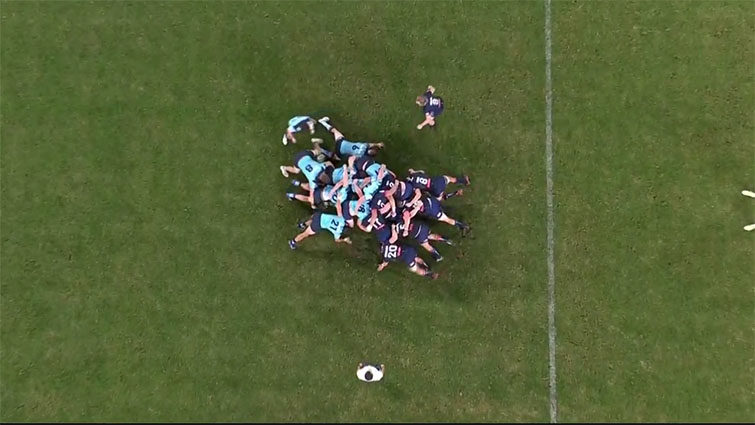
The low bind allows Cabous Eloff to drop inside and follow Jordan Uelese through the middle of the Waratahs scrum to win a game-clinching penalty. Eloff is, incidentally, a prop well worth a look from the Wallabies coaches as a support tighthead in 2021.
Who should be the halves pairing for the Lions?
– Tim Westphal
With most head contact in a tackle now leading to a sending-off, is it worth going for a dominant chest tackle when the slightest miscalculation or accident can see these shots hitting the ball carrier high?
– tighthead
May I throw Owen Farrell’s name into the mix?
– Just Nuisance
Folks, it’s Lions watch time again! Warren Gatland has always tended to prefer a solid tactical navigator and a big defensive number ten in his teams, so my guess that the likes of Owen Farrell, Dan Biggar and even Johnny Sexton will be preferred to Finn Russell and George Ford.
One of the reasons you need a strong high tackler there is South Africa will pick a giant inside centre to run straight down that channel – a Damian de Allende (1.91m and 105 kilos) or an André Esterhuizen (even bigger at 1.94m and 115 kilos).
If you cannot stop de Allende and Esterhuizen or prevent them from passing through contact, it is unlikely you will be able to stop the Bokke power game. This presents some problems with the current refereeing sensitivity to shots at shoulder height.
Remember what happened the last time ‘Faz’ and Esterhuizen clashed in an England versus South Africa game?
At the time (November 2018), this tackle did not even incur a penalty. In the current climate, it would definitely be worthy of a card – the only question would be the colour. Warren Gatland is sitting on the horns of a dilemma.
Thanks to all of those who contributed once again, unanswered questions will be stored for future issues.
Original source: https://www.theroar.com.au/2021/04/30/coachs-corner-issue-10-how-loose-can-you-be/
https://therugbystore.com.au/coachs-corner-issue-10-how-loose-can-you-be/
Thursday, April 29, 2021
Super Rugby tipping panel week 11: Finals time and more blues for the Blues
Yes, finals time has arrived in Australia, but there’s one more chance to see the Blues fall short in New Zealand, which will entertain Brett and anyone else who’s had it in for them for years.
The form teams either side of the Tasman might just be the Chiefs and Force, which seems like a crazy thing to be saying after the positions both teams found themselves in just a month ago.
But no-one else can match their current three-game winning streaks. The Force have, well… *forced* their way into the AU finals, while the Chiefs are already locked in for the NZ decider.
And this is the best part for you anti-Blues types: the Chiefs are five points clear of the Blues, and the two sides meet on Saturday. A bonus point win would draw the Blues level on competition points, and a win would certainly give them a better for-and-against record.
BUT! The Chiefs would still have one more win – and with NZR employing the same tie-breaking method SANZAAR employed for Super Rugby (number of wins, then best points differential, then best differential between tries scored and conceded, then the number of tries scored. And then a coin toss), a Blues win this weekend will have them fall short by technicality!
Honestly, it might be the most Blues of all the Blues failures. Yes Brett, you can use that line if you want…
LAST WEEK: Brett, Dan, Digger and The Crowd 3; Harry and Geoff 2.
OVERALL: Harry and Dan 28; Geoff 27; The Crowd 26, Brett and Digger 25.
Digger
TIPS: HURRICANES, CHIEFS, BRUMBIES
With neither of the New Zealand games actually affecting who turns up in the final it’s all a bit of charity footy this week so will start with the big knock out game over in OZ, the winner gaining the ticket to the big dance with the Reds.
Naturally, the Force will take a lot of confidence out of there win over the Reds, a feat only they have managed to achieve thus far this season and will rightly fancy themselves a decent chance to knock over the Brumbies as well.
I simply do not believe they will however, the ‘been there done it before’ is always a useful asset of which the Brumbies have plenty and I think they will squeak it and set up a 2020 final repeat, albeit a different venue.

Allan Alaalatoa. (Photo by Asanka Ratnayake/Getty Images)
In NZ, the Chiefs have certainly shown they know how to win and indeed, expect to win and I simply do not have any faith in the Blues to do anything about that.
Chiefs to take momentum into the final, and in Wellington in the pre-season match before the trans-Tasman comp, I will pick the Hurricanes based on not much at all really other than simply, that’s what I want to happen, therefore I shall will it to be.
SURE THING: Thrush will irritate someone, good or bad while Jordie will sink something from 50 plus and our own Rugby Tragic will be upset about the Blues and rolling mauls in general, again while Harry will be happy, as always, about anything.
Brett
TIPS: HURRICANES, CHIEFS, BRUMBIES
There is no better time for the Hurricanes to find some form, and I think this might be the week. Well actually, a month ago would have been a better time, but you get the point.
They’ve been done by Damien McKenzie (who hasn’t?) and golden point in recent weeks, so they’re overdue some good luck. And with nothing on the line for either the Hurricanes or the Highlanders, home ground advantage probably helps.
Home ground advantage may help in Auckland too, but honestly, who cares?!? I don’t. Go Chiefs.
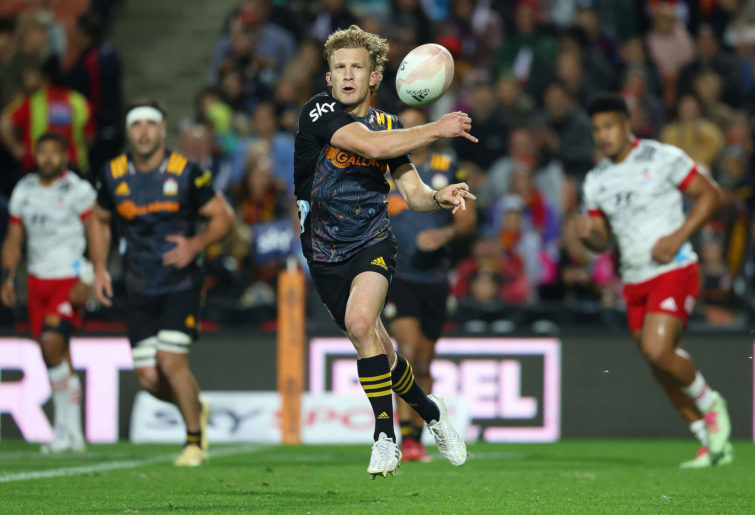
Damian McKenzie. (Photo by Michael Bradley/Getty Images)
And home ground advantage will certainly help in Canberra because it almost always does in finals. It will be some feat if the Force can win against this trend in their first finals appearance, and full power to them if they can.
I think there’s less than 10 points in this, and I’m genuinely looking forward to the contest, because this feels like a big moment in the history of the Western Force. I don’t think I will, but I’m not sure I’ll mind too much if I get this one wrong.
SURE THING: The Blues, with nothing to gain, and several weeks too late, will roll out their performance of the season to remind everyone of why this really was going to be their year. And at some point soon after, we’ll all remember the few weeks previous, and remind ourselves of why it still isn’t.
Dan
TIPS: HURRICANES, BLUES, BRUMBIES
A trio of home teams for me this week.
Having never been behind at the 80-minute mark of their last two games, the Hurricanes were desperately unlucky to go winless in those fixtures. Against the one team they’ve beaten this season, a change of fortune looms.
The Blues might have been listless in attack last week, but they weren’t as bad as the scoreline suggested. The Chiefs could have half an eye on their May 5 decider, and they don’t have the same ability to ruthlessly repel opposition attacks as the Crusaders – a welcome change for the Aucklanders.
The Blues, then, to finish their season with a consolation win.
Then to the match that really matters: the qualifying final between the Force and Brumbies. Will the former’s fairy-tale flight to the final continue? Probably not, but it’s been great to see them get to the post-season nonetheless. The Brumbies will be rested, boosted by their home fans, and simply boast the stronger team. Can’t tip against ‘em.
SURE THING: Rob Valetini will poleaxe someone either with a run or a tackle, and probably both.
Harry
TIPS: HURRICANES, CHIEFS, BRUMBIES.
And now, the end is near, and as I face my final curtain, my friends, I’ll make it clear, I’ll state my case, of which I’m certain.
Yes, there were times, I’m sure you knew, when I bit off more than I could chew, especially that time, with the jambalaya juice on the bay, with Digger, and through it all, whenever there was doubt, I ate it up and spit it out. I faced it all and stood so tall. I did it my way.
So, the tips.
The Hurricanes are led by a raccoon-capped fullback. Will it be their Alamo? No. They will survive the Highlander rebellion, because the Southern Island boys are fatigued. Wes Goosen to score a hat-trick; and Jordie Barrett to do a trick with his hat.
More Rugby
- Super Rugby tipping panel week 11: Finals time and more blues for the Blues
- The shifting fortunes of the Blues and the Chiefs
- Tahs: What was I hoping for and what did I get?
- Brumbies' Slipper wary of familiar Force
- Super Rugby AU qualifying final teams: Brumbies bring back big guns as Force make selection surprise at the back
The Blues are a good team with flaws. The Chiefs are a flawed team that’s good. But, the Chiefs have been lucky, and the Blues very unlucky. Which way will the luck turn? Again, I’ll return to my doctrine: the Chiefs 9-10 is better than their opposite Blues numbers. Chiefs by the hair on my chinny chin chin.
The Brumbies will roll the Force into little piru-shaped pieces and eat them up.
SURE THING: Rugby will be the big winner, there will be games with two halves, skippers will be proud of their boys, the margins will be said to be fine, and nobody will blame the ref, because we aren’t on a soccer site.
Geoff
TIPS: HIGHLANDERS, BLUES, BRUMBIES
The Hurricanes almost did me proud last week, but in the end, raccoon head couldn’t quite do the Stray Cat strut. They’re overdue a win, but if they catch the Highlanders on the wrong day, their misery will continue.
Having picked the Chiefs resurrection earlier than everyone else, I’ve given those points back by jumping off the bandwagon too soon! I’m going to give them one more chance to lose again this week – it really is time for the Blues to show something at home.

Otere Black. (Photo by Phil Walter/Getty Images)
Only the most blue-eyed optimist could really expect a Force win in Canberra. Of course, they’ll scrap and stay in the contest. But they ain’t winning.
SURE THING: Christchurch’s poor young boogie woogie bugle boy from company ‘B’ will have been flogged on the training track on Monday, and has been banished to the bench, but the extra scales put in at practice should hold him in good stead for when he next gets the call up.
Sports opinion delivered daily
| AU-QF / NZ-10 | Harry | Brett | Dan | Digger | Geoff | The Crowd |
|---|---|---|---|---|---|---|
| HUR v HIG | HUR | HUR | HUR | HUR | HIG | ? |
| BLU v CHI | CHI | CHI | BLU | CHI | BLU | ? |
| BRU v FOR | BRU | BRU | BRU | BRU | BRU | ? |
| Overall | 28 | 25 | 28 | 25 | 27 | 23 |
| Last week | 2 | 3 | 3 | 3 | 2 | 3 |
Get your votes in now. The Crowd’s tips will be revealed Friday afternoon AEST.
if (!Element.prototype.matches) Element.prototype.webkitMatchesSelector; document.addEventListener("DOMContentLoaded", function() var request = new XMLHttpRequest(); request.open('POST', '/wp-admin/admin-ajax.php', true); request.setRequestHeader('Content-Type', 'application/x-www-form-urlencoded;'); request.onload = function () if (this.status >= 200 && this.status < 400) document.getElementById("at-submit-tips-inner").innerHTML = this.response; document.addEventListener('click', function (event) if (!event.target.matches('.margin-tap-targets span')) return; var match = event.target.getAttribute('data-match'); var points = event.target.getAttribute('data-points'); var marginField = document.getElementById('at-margin-'+match); marginField.value = marginField.value*1 + points*1; , false); else console.log(this.response); ; request.onerror = function() // Connection error ; request.send('action=at_insert_submit_tips&title=Your Tips&comp_id=8&round_id='); );Original source: https://www.theroar.com.au/2021/04/29/tipping-panel-week-11-finals-time-and-more-blues-for-the-blues/
Social media boycott: Premiership Rugby & English cricket joins football in move to tackle abuse
Original source: http://www.bbc.co.uk/sport/cricket/56915338
Wednesday, April 28, 2021
Joe Launchbury: Wasps lock to miss British and Irish Lions tour with knee injury
Original source: http://www.bbc.co.uk/sport/rugby-union/56902862
Wise old heads prevail as the Force awakens
I hate to say I told you so, but this is how I summarised the Western Force’s Super Rugby 2021 prospects last December:
“The Force should certainly be strong enough to win at least 50 per cent of their games in 2021, and that may be enough to slingshot them into local play-off contention.”
That comment formed part of an article which suggested the addition of ex-Reds second row Izack Rodda as part of the Force’s ongoing trawl for new talent.
“From this point of view, the best Christmas gift Sampson could receive would be the news that Izack Rodda wants to return to Australia – more precisely, to Western Australia.”
Rodda duly signed with the Force in March.
There is no doubt whatsoever that the quality of the recruitment drive in Western Australia has surpassed all of its peers in the country, despite the loss of ace Argentine hooker Julián Montoya to the Leicester Tigers on the eve of the tournament.
The Force badly needed to find some speed and finishing ability in the back three, and they got it in a part-exchange loan signing from Tigers, ex-England age group wing Jordan Olowofela. The Welford Road academy graduate bagged a hat-trick of tries in the weekend nail-biter against the Queensland Reds.
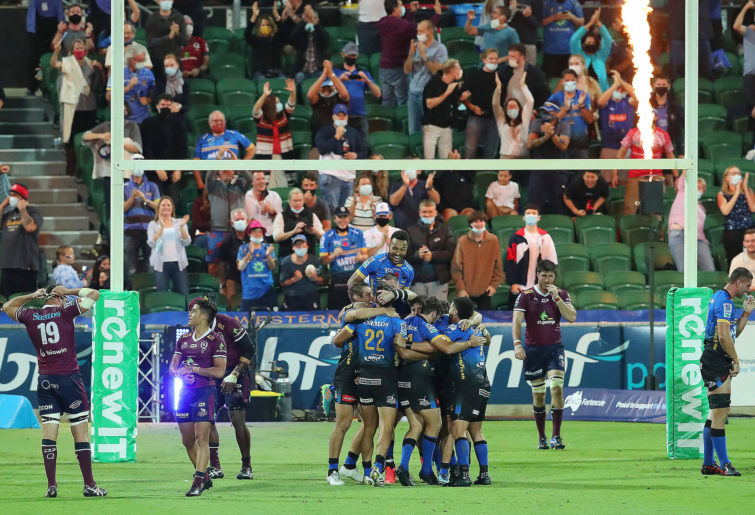
Jordan Olawofela was pivotal in the Force’s win over the Reds. (Photo by Will Russell/Getty Images)
Tim Sampson and his coaches unearthed Feleti Kaitu’u to replace Montoya, and he was selected in Dave Rennie’s first Wallaby squad of 2021. They found Tim Anstee in Australian sevens and he made it to Rennie’s camp, too.
All of the signings for the 2021 season (bar Tomás Lezana) – Tom Robertson, Santiago Medrano, Sitaleki Timani and Anstee up front; Tomas Cubelli, Domingo Miotti, Tevita Kuridrani, Rob Kearney, Toni Pulu and Olowofela behind – have been fully integrated as starters as the team have continued the steady upward curve of their development.
If the Force beat the Reds anywhere (other than the scoreboard) on the field on Friday evening, it was in the maturity of their leadership. James O’Connor has been touted as a Wallaby captain in 2021, but the relationship between O’Connor and club captain Liam Wright did not work out particularly well on the night.
The Reds started by taking two close-range attacking scrums against the Force when they were down to 14 men, and they scored tries from both. So far, so good.
The clarity of the decision making started to unravel in the second period, with Queensland opting for scrums in the 65th and 79th minutes against a full, 15-man defence. The last failed attacking scrum decided the fate of the game in the Force’s favour.
When the hosts awoke to the fact that they could win the match in the third quarter, there were plenty of veteran Yodas willing and able to steer the ship home. Jeremy Thrush and Tevia Kuridrani may be far more limited in the range of their movements than they were at their athletic peak, but both still know how to influence the course of important games at critical moments.
Kuridrani – now ruled out of the preliminary final against the Brumbies – dredged his muscle memory to relive the day when he was the most powerful, dominant back on the paddock. It all started with a huge hit on his opposite number Hunter Paisami, which immediately ended the Queensland man’s interest in proceedings:
Tevita spots his opposite number coming hard onto the angled ball off Tate McDermott, and the first lesson is crystal clear: never give Tevita Kuridrani a definite target!
Kuridrani’s influence was also felt via his communications skills – first, on defence:
He throws up an arm to keep Olowofela away from the ball which Domingo Miotti has hacked ahead – pick it up, and he will be pinged for offside:

With the English wing backing off, Kuridrani is able to make another offensive tackle on Bryce Hegarty and set up a successful jackal by Miotti behind him. The penalty goes the other way.
The big man’s communication on attack was just as good.
Take a look at the three-minute mark on the above highlights reel. As the ball is spun out to the left, Kuridrani knows he is marked by Hegarty and signals for the ball to go over the top to Olowofela directly:
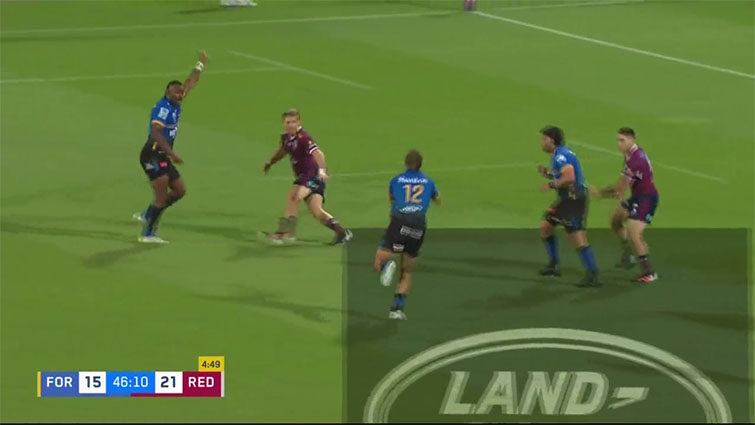
Kyle Godwin duly obliges, and Olowolofela is able to score his second try of the game.
When Kuridrani finally departed in the 74th minute, it was a case of replacing one 30-year-old with a 35-year-old guru in the shape of Richard Kahui. Kahui still had the time to make two decisive interventions, the first of which was putting through a perfectly weighted left-foot kick for Olowofela to score the final try (which can be seen at five minutes on the highlights reel).
In the final act, Kahui held up Josh Flook over the goal-line to force a maul turnover:
The two men assisting him are Godwin and Jeremy Thrush. The Force second row was also highly instrumental in spotlighting some Reds’ weaknesses which had previously been masked by their wins.
At 36 years of age, Thrush is the most venerable of all the Yodas at the Force, and has accumulated a lifetime of lineout wisdom. The Reds struggled on their own throw, losing four lineouts out of 13 to first touch, with three of those converted to full turnovers.
With Angus Scott-Young in his debut season as a lineout caller, the Queensland set-piece is quite straightforward. The majority of throws are pre-called before the forwards enter. Thrush knew exactly where to position himself to mount a contest:
He knows the ball is going to Lukhan Salakaia-Loto in the middle, and the Force forwards close the gap on the Reds big man before the throw is ever made – less than half a metre separates the two lines as Brandon Paenga-Amosa delivers the ball, and that gives Thrush a realistic shot in defence:
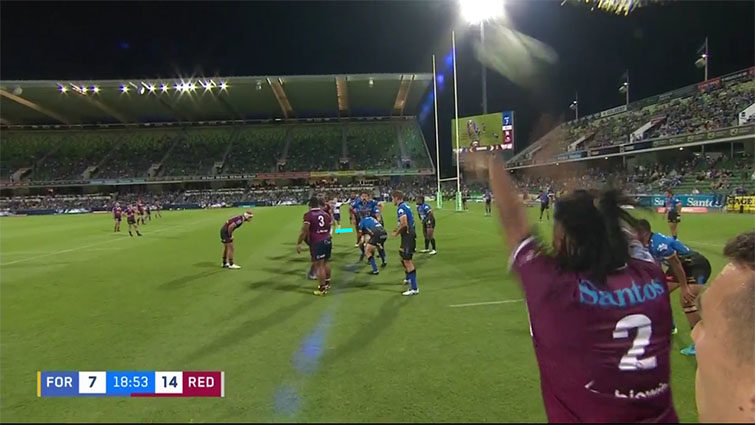
The signs that Thrush had read and understood the Queensland lineout before a ball was ever thrown were plain at one second-half set-piece:
Thrush is so certain of the target area that he is able to make the steal look for all the world like a blue throw, not a maroon one.
He was just as effective when he chose to compete on the ground.
Thrush is able to swim past the receiver, Liam Wright, and onto Alex Mafi, who is the ball-carrier at the back. That is the lineout drive stuffed.
The other area of weakness highlighted by Thrush’s activity was the vulnerability of scrumhalf Tate McDermott at the base. In a recent Coach’s Corner column, I outlined how McDermott’s tendency to stand tall and lift the ball off the ground before passing could create a problem for the attack.
The Force obviously had a plan to pressure McDermott from his kicking (right) side, and it was put into action from the start:
Thrush is positioned to block the box-kick and he nearly gets into Bryce Hegarty’s exit, just for good measure. It was a repeated issue, and not only in obvious kicking situations:
The final counter-ruck by Thrush is especially instructive. The Force have McDermott just where they want him – standing tall in the saddle and out of sync with the support outside him – and it takes an outstanding, high-risk offload by Taniela Tupou to rescue the play:
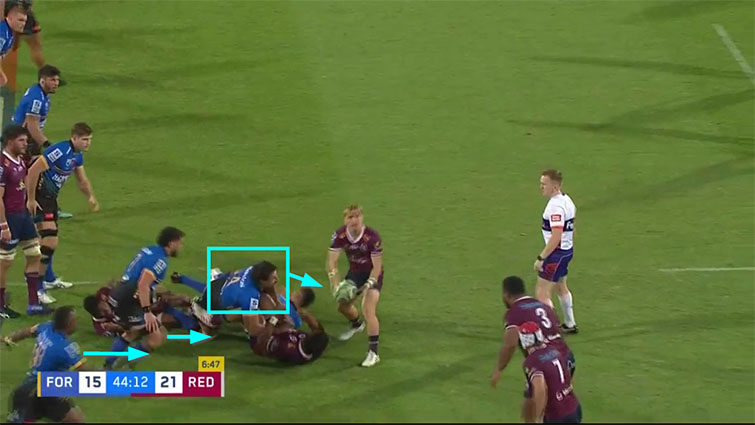
Summary
Both Tevita Kuridrani and Jeremy Thrush may have spent ten minutes in the sin bin after receiving yellow cards, but their positive contributions still comfortably outweighed the negatives against the Reds. It was a game where the leadership of the old souls in the Force made most of the difference.
In the process, some of the Queensland fault lines, previously masked by their long winning run, have become more evident. There is a question about who is really captaining the side after Liam Wright’s long-awaited return from injury. The choice to take scrums from close range in the second half, against 15 men, ultimately cost them the match.
The Reds have also backed themselves into a corner by delegating the lineout calling to Angus Scott-Young. Scott-Young has made a decent fist of the job, with an 86 per cent success record across the regular season. At this stage of proceedings, it is too late to change to someone else.
But it also means he has to start the game ahead of players who could add more potential value to the Reds’ cause in the grand final – Wright in the back row, or Seru Uru (the Reds’ best lineout player) in the second row.
Whoever reaches that final, whether it is the Force or the Brumbies, will have noticed the fragility of the Reds’ lineout under pressure. Queensland were confined to winning ball from the front or middle of the line, and that is not ideal.
They will also have observed Tate McDermott’s vulnerability at the base when kicking or passing. The last game of the season is very far from a foregone conclusion, regardless of the contestants.
In the meantime, the advances the Force have made from a near-death experience have to be admired. They have not only re-awakened, they have come back from the dead, and are one tantalising step away from a domestic final.
They can no longer be counted as the fifth team in Australia – even if the idea of maintaining five genuinely competitive professional franchises still seems as improbable as ever.
Original source: https://www.theroar.com.au/2021/04/28/wise-old-heads-prevail-as-the-force-awakens/
https://therugbystore.com.au/wise-old-heads-prevail-as-the-force-awakens/
Tuesday, April 27, 2021
Get your questions in for Issue 10 of Coach’s Corner
The weekend of rugby is over, so you know what that means: it’s time to get in some questions for this week’s instalment of Coach’s Corner.
If you haven’t come across the column yet, it’s the weekly article where, each Friday, our resident rugby analyst Nick Bishop answers your queries about what’s happening on the field.
Miss the latest issue of Coach’s Corner? Don’t worry, you can catch up right here!
The last round before the Super Rugby AU finals served up plenty of drama, with the Force snatching a famous win against the previously undefeated Reds to book their place in the post-season and the Rebels finishing their season on a high by beating the winless Tahs.
Over in New Zealand, Damian McKenzie came to the fore with yet another clutch, game-winning kick, before the Crusaders booked a home final by comfortably dealing with the Blues.
That leaves a qualifying final in Canberra between the Brumbies and Force this weekend, while the Saders will put their feet up during Round 10 of the Aotearoa competition. We’re also drawing ever closer to the announcement of the British and Irish Lions squad.
If you have any questions about those topics, or a completely different rugby-related topic, be sure to drop them in the comments section below.
Remember to err towards being nice and specific with what you’re asking, as more general questions aren’t as easy to answer in the confines of a single article.
So, leave your comments below, and come back on Friday to see what answers Nick has for you!
Original source: https://www.theroar.com.au/2021/04/27/get-your-questions-in-for-issue-10-of-coachs-corner/
https://therugbystore.com.au/get-your-questions-in-for-issue-10-of-coachs-corner/
'Why it is an honour to win such a physical Women's Six Nations final'
Original source: http://www.bbc.co.uk/sport/rugby-union/56871532
https://therugbystore.com.au/why-it-is-an-honour-to-win-such-a-physical-womens-six-nations-final/
Monday, April 26, 2021
The Wrap: How to fix Super Rugby? Leave it alone
The Anzac Day round is always one filled with poignancy, and despite a young bugle boy struggling to hit the right notes in Christchurch, there were moving ceremonies held at all four matches across the weekend.
The only shame was that we weren’t blessed with a trans-Tasman match up; a situation that, depending on how events play out, will be rectified for next year’s round.
Not that anyone in Perth cared a jot, with the Force upsetting the previously unbeaten Reds, 30-27 to storm into the preliminary final next week, against the Brumbies.
Reds’ captain Liam Wright said straight after his side’s loss that “the Force deserve a lot of respect”, and he was clearly telling the truth.
Any side, under the pressure of playing for its first ever finals spot, seemingly down and out midway through the first half, having to battle through thirty minutes with 14 men, that is able to come back and score the winning try in the final minutes, is made of special stuff.
But the question that should have been put to Wright, is why, with the Force deserving of so much respect, was a gift three points under the posts to tie the match and send it to golden try, ignored? In favour of sending their smallest outside back on a crash ball, to be swallowed up by a mass of defenders?
It was easy to get caught up in the romance of the Force’s victory, and let’s be clear – who couldn’t love the reward that came for their commitment, determination and self-belief?
But starting with West Australia being sent into another Covid lockdown on Friday, there was so much confusion around, perhaps it was no surprise that the match should end as it did.
Pre-game, a Stan graphic told us how the Reds were “undefeated in six of the previous eight matches against the Force”. That made about as much sense as referee Damon Murphy somehow deducing that Domingo Miotti nudging the ball forward off his forearm didn’t constitute a knock on, before flying winger Julian Olowofela ran in the first of his three tries.
More Rugby
- The Wrap: How to fix Super Rugby? Leave it alone
- Six talking points from Super Rugby AU and Aotearoa
- What should the Reds and Wallabies do with Liam Wright?
- Wallaby Hooper eyeing Japan rugby title
- Crusaders vs Blues: Super Rugby Aotearoa live scores
No matter the confusion, this match was all about the vibe. Even Stan’s best analyst, Morgan Turinui, got caught up in the craziness, noting that while Miotti had clearly knocked the ball on, he was happy to see a try awarded; seemingly speaking for many in implying that it was ok to apply different laws for the underdog.
It was also about the Force doing two other things outstandingly well. One was Tevita Kuridrani dispatching Hunter Paisami to the sheds to count how many ribs he had left after an inspirational mid-field tackle; an effort which visibly lifted his side and the sea of blue, in unison.
The other was to play the referee off a break at the scrum. Clearly under early pressure from the competition’s leading scrum, the Force front row managed to not only neutralise that threat, but squeeze three penalties out of Murphy without even having to scrummage.
After a season where, at times, they struggled to play a lot of rugby, the Force deserve their trip to Canberra next week because they went about things intelligently, getting the match played, for the most part, on their terms, and cleverly identifying space in behind the defensive line, where Olowofela was easily able to outrun James O’Connor for the go ahead score.

(Photo by Will Russell/Getty Images)
Reds’ fans meanwhile will find solace from the time-worn ‘it was the loss we needed to have’ explanation, although I’m not so sure that’s something I’d want to be hanging my hat on, heading into the grand final.
Their lineout looked more like the stuttering 2019 version, and their much-vaunted loose forward trio found their match in the hard-working Force combination.
And whoever their final opponent is, it might be an idea for the Reds to not only talk about showing respect for them and for the match situation, but to actually do so.
The Force getting the job done put the Rebels out of business, rendering their 36-25 win over the Waratahs moot, although as was obvious from the reaction of the players, any Super Rugby win is a win to be treasured.
As is their custom, the Rebels made things harder for themselves than they needed to be, with both Isi Naisarani and Pone Fa’amausili sailing too close to the wind with bone crunching defence, and in the process, earning the displeasure of referee Nic Berry.
It will be interesting to see what kind of vision is available to the judiciary, and whether or not it establishes – in both cases – that direct contact was made to the head, as opposed to the head being thrown back due to the force of the collision, or being a point of secondary contact.
Clearly, both players need to aim lower, to remove the element of risk to themselves and their opponent, but I’m yet to be convinced that fuzzy-framed, one-dimensional images are what we should be hanging people on.
It’s been a strange season for the Rebels, never able to put in a convincing 80-minute performance, and coming out on the wrong side of a string of match-defining moments.

(William West/AFP via Getty Images)
With a solid set piece and tenacious defence, they will expect to acquit themselves well against the New Zealand sides, although better combinations and more fluidity in the backline will be needed.
As for the Waratahs, Angus Bell once again showed his mobility, and Izaia Perese took things up another level with elusive running and skilful offloads.
But the Rebels finishing them off with a classic ‘seven-man shove’ at the scrum, really summed up the Waratah’s season in one humiliating moment.
In Hamilton, there was high interest in the battle of the two form fullbacks, Jordie Barrett and Damian McKenzie. Barrett raised concern early, with some watchers concerned that he disrespected both animal activists and Anzacs by wearing, then not removing, a Daniel Boone-style, coonskin cap for the anthems.
Barrett delivered his customary penalty goal from his own side of halfway, but despite a valiant effort from the Hurricanes, it was McKenzie who buried them, nailing a final minute penalty to seal a 26-24 win.
The Chiefs have won their last five matches by six, three, three, one and two points respectively. McKenzie has been the final points-scorer and match winner in every single one of those matches.
He’s never been a first-choice All Black, and with the emergence of Will Jordan he will almost certainly continue to play sporadically, and as injury cover, utilising his versatility.
But regardless of what happens up the line, there can be no doubt that he currently owns Super Rugby Aoteoroa, and is one of the main reasons fans tune in, knowing that they are guaranteed high-quality entertainment.
The Hurricanes did plenty right, and could consider themselves unlucky not to close the match out, just as they fell short against the Crusaders. In part that was down to being exposed by the inexperience of their young halves, who lacked the composure and experience to take the options demanded by such a tight and tense situation.
Ruben Love and Cameron Roigard are talented players; they just need miles on the clock to adjust to the tempo and situations faced at this level.
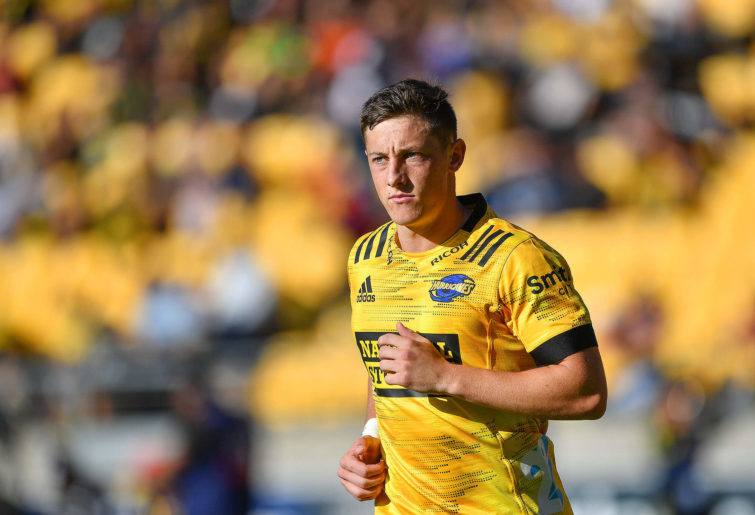
Ruben Love. (Photo by Mark Tantrum/Getty Images)
It’s a scenario no different to that say of the Reds, where their coach Brad Thorn and many of this year’s well performing team suffered through three very tough seasons, copping some harsh outcomes while those rugby lessons were being absorbed.
One player who has raced through his apprenticeship is Will Jordan, whose two tries helped the Crusaders to a comfortable 29-6 win over the Blues, and ensured that the final will once again be played in Christchurch.
As has been the case in recent times, the Crusaders suffered through some flat patches, struggling to contain the Blues’ loose forwards, on both sides of the ball. But their superior cohesion and strike power, and Sam Whitelock’s work-rate, proved a telling difference.
They’re not unbeatable, but if I’m to bet against them in the final, it will be with someone else’s money.
After starting the season so powerfully, the Blues now have it all ahead of them, needing to beat the Chiefs with a bonus point, while preventing the Chiefs from getting a bonus point themselves.
Not impossible, but missing the presence of Patrick Tuipolotu and Tom Robinson, and without real authority in their halves, they don’t look like a winning proposition right at the minute. The sight of the excellent Dalton Papali’i hobbling at the end of the game wouldn’t have made Blues fans feel any better, either.
With finals action about to begin, followed by an eagerly awaited cross-over round, thoughts have swung towards the competition format for 2022; particularly with the anticipated introduction of the Fijian Drua and Moana Pasifika into Super Rugby.
With the Australian competition vastly improved and New Zealand’s always being of a high quality – not to mention the high number of close, exciting finishes in both – it would be a brave or foolish administrator who strays too far from the current model.
We may have got to this point by accident, but the existing Super Rugby AU and Super Rugby Aotearoa model is working. Mess with it at your peril.
Original source: https://www.theroar.com.au/2021/04/26/the-wrap-how-to-fix-super-rugby-leave-it-alone/
https://therugbystore.com.au/the-wrap-how-to-fix-super-rugby-leave-it-alone/
Premiership: Wasps 39-29 Bath - Thomas Young scores twice in Wasps win
Original source: http://www.bbc.co.uk/sport/rugby-union/56836947
https://therugbystore.com.au/premiership-wasps-39-29-bath-thomas-young-scores-twice-in-wasps-win/
Sunday, April 25, 2021
Matt Toomua urges the Rebels not to sack Dave Wessels
Melbourne captain Matt To’omua says sacking coach Dave Wessels after the Rebels failed to make the Super Rugby AU finals isn’t the solution to the club’s woes.
Wessels has mounted a passionate defence for Melbourne’s failure to reach the Super Rugby AU finals and boldly declared the Rebels can win the trans-Tasman version of the competition.
The Rebels ultimately missed the three-team playoff series by one competition point after beating the winless NSW Waratahs 36-25 in Saturday night’s ‘dead rubber’ in Sydney.
Wessels rued four last-minute losses and pointed out that the Rebels played almost the entire eight-round competition without up to a dozen leading players, including Wallabies stars Reece Hodge, skipper Dane Haylett-Petty and Isi Naisarani.
“We lost four games on the last kick of the game after the hooter,” Wessels said.
“We could be sitting here with a totally different story.
“We’ve also gone through the season without nine or ten of our most experienced players.
“So I’m really proud of the young group. I think the average number of caps in our team is 12.”
While acknowledging professional sport was a results-based business, Rebels captain Matt To’omua said sacking the coach wasn’t the solution.
To’omua insisted Wessels retained the full support of the playing group.
“We also understand the chat around. It’s essentially people wanting results and we’re not getting them at the moment,” he said.
“But it’s a short-sighted view to think that you just change one thing and (it will be okay). It’s not the way to go forward so we’re 100 per cent behind him.
“We’ve got to make some improvements in our program – 100 per cent – but Dave’s our guy. He’s the one we want leading us.
“The big thing for us this year was we were missing so many players, so much experience.
“It’s fine margins.”
Wessels urged the Rebels board to put the 2021 season into perspective, given the upheaval because of the pandemic.
“We didn’t train at our home base until the middle of March. We didn’t have one training session on our own field until then,” he said.
“Even now, we don’t have control over field time because we share the field with another team.
“And we don’t have our own gym because of COVID. You’re not allowed to share that space. We have to drive another 30 minutes to another gym.
“Unfortunately we missed out (on the finals) by a point – but I’m definitely proud of the effort.”
Original source: https://www.theroar.com.au/2021/04/25/matt-toomua-urges-the-rebels-not-to-sack-dave-wessels/
https://therugbystore.com.au/matt-toomua-urges-the-rebels-not-to-sack-dave-wessels/
Women's Six Nations: England show winning character but need plan B for World Cup
Original source: http://www.bbc.co.uk/sport/rugby-union/56871396
Friday, April 23, 2021
Why Australia needs a professional rugby sevens comp
With the COVID-19 pandemic predictably making the World Rugby Sevens Series an impossibility in 2020, fans longing for the thrill-a-minute excitement and laid-back, party atmosphere of the touring series have been forced to curb their enthusiasm until the 26th of July when the world’s best begin their battle for gold at the rescheduled Tokyo Olympics.
The shortened version of the 15-a-side game will feature for the second time following the code’s 92-year hiatus from the global sporting event.
The marketing potential of the seven-a-side format has long been noted. HSBC’s 2016 report The Future of Rugby found it the fastest-growing sport in the world and with its inclusion in the Olympics attracting an estimated 30 million fans, it has proven to be a valuable instrument in rugby’s bid to win over new supporters. The carnival-style tournament can draw in fans who might otherwise fall outside of rugby’s traditional demographic with loud music, audacious attire and wall-to-wall action.
Australia found itself experiencing a significant boost in participation following the national women’s sevens side claiming gold at the Rio 2016 Olympics. Off the back of their success rugby union saw its first increase in total participation nationwide since 2012, with national primary school program Game On jumping in participation from 9900 to 39000. That particular program catering to 60 per cent public schools, an area rugby has traditionally struggled to engage.
Speaking to the ABC in 2016, then Australian Rugby (RA) participation growth manager Cameron Tradell talked on the potential of rugby sevens to replicate the resurgence of Australian cricket through the Twenty20 Big Bash League, “Sevens has the same explosiveness around what is happening on the field, and the expectation of the unknown when you head to a sevens game is very similar to the BBL,” Tradell said.
“I think the fact it is genuinely seen as being an equal opportunity game because of the success of the girls puts us in a stronger position than cricket with regards to having so much opportunity to showcase the nuances between the male and the female game.”
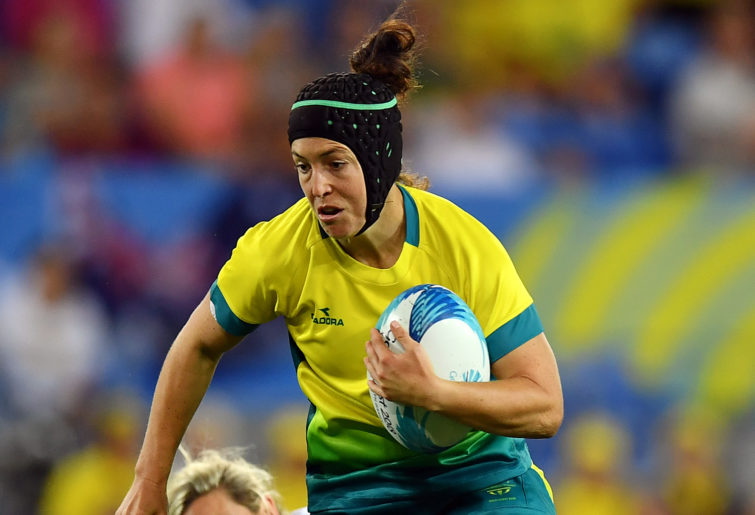
Emilee Cherry of Australia. (Photo by Dan Mullan/Getty Images)
Given Tradell’s words and the building anticipation around the next Olympic appearance, one begins to wonder why moves have not been made to introduce a professional national rugby sevens competition.
The introduction of the AON sevens in 2017 proved a step in the right direction. The four-tournament series successfully bringing together Australia’s best women in a ten-team competition featuring some of Australia’s top universities from almost every state and territory. The competition has provided a clear pathway for players seeking to earn a professional contract with Rugby Australia, strengthening the national player pool and provided a platform for national selectors to prospect talent.
Yet, there has been little mention of such an equivalent for men despite new broadcast partner the nine network signalling their interest. Surely with the proven growth and inherent marketability of rugby sevens, it must be time to start discussing how we can expand the game. Australia has the opportunity to pioneer a whole new market beyond the rugby crowd and reach out to would-be fans who may think of rugby as too boring or complicated and show them what our sport is really about.
With the backing of a willing broadcaster keen to show off their newest jewel and hopefully another successful Olympic campaign, now is the time to put the wheels in motion on a platform that will showcase our top rugby sevens talent on our screens and at our stadiums. The infrequent nature and geographical limitations of the World Sevens Series can no longer cater to the growing appetite for all-day action, costume coordination, day drinking and Sweet Caroline sing-alongs.
More Rugby
- Why Australia needs a professional rugby sevens comp
- Cutting the pack: Force vs Reds
- Coach’s Corner Issue 9: Can old - or small - dogs learn new tricks?
- Why Japan is a threat to Australian rugby
- What South America can learn from Super Rugby
The option to play in summer makes the prospect all that much sweeter. Not only do the sunny days provide suitable conditions for a good time, they also present the opportunity to catch the hungry eyes of cross-code fans. The tournament setups lesser need for long-term commitment along with the emphases on entertainment and lower bar of law comprehension could help draw in those bored fans.
On top of helping rugby expand into the markets of other codes, sevens could also aid in rugby’s bid to win support outside of its traditional heartlands. A conquest that has proven difficult for Rugby Australia in recent years could be simplified with sevens’ lower requirement for talent depth and limited need for travel.
One could safely assume that providing a platform and exposure to players who might normally fall outside of the scope of elite rugby, like those outside of traditional heartlands and players on the fringes of rival codes, would translate to increased participation. Paving the pathway for the next Maurice Longbottom.
Rugby Australia, through the success of Super Rugby AU and despite the now-defunct status of the National Rugby Championship (NRC), have proven that they can, at least structurally, sustain a competitive national competition. Though little can be said for the marketability of the ladder, RA now with the backing and brains of the nine network media machine has the means to put together an enticing and potentially profitable product.
For too long Australia has treated rugby sevens as little more than a feeder to the 15-man code. Our national men’s side has suffered from chronic inconsistency, with top players being plucked away to train with Super Rugby sides, forcing the introduction of players with limited sevens experience.
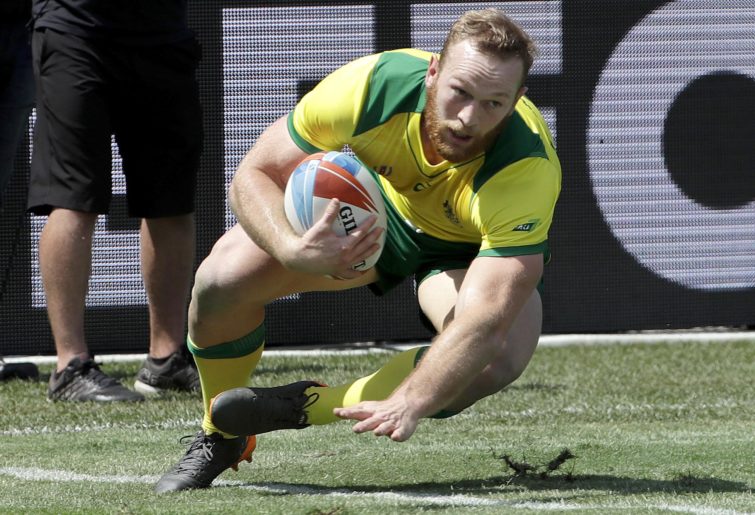
Australia’s Boyd Killingworth. (AP Photo/Jeff Chiu)
While perhaps the proposed national club championships or any other such form of NRC replacement should, rightfully, be the priority. The potential reach of rugby sevens could very well put it on equal footing to the proposed state of union, Queensland vs New South Wales representative match up that some consider to be too contrived.
Even if the reality is a long way from now, we can continue to expose the public to the game of rugby sevens and all its chaotic glory. If a male equivalent to the AON Sevens is for whatever reason considered unfeasible, at the least a more coordinated front is needed to display the top domestic male sevens talent in Australia on a regular basis, keeping one eye on moving the operation to the next level.
We must wake up to the potential of rugby sevens and harness its growing power. While I understand that money may be tight at RA headquarters at present and I’m aware of the time and money necessary for a proposal like this, whether they roll the dice or play it steady, the rewards could prove to be numerous.
I’ll turn it over to you guys now. Let me know what you think of the idea and how it might look.
Original source: https://www.theroar.com.au/2021/04/23/why-australia-needs-a-professional-rugby-sevens-comp/
https://therugbystore.com.au/why-australia-needs-a-professional-rugby-sevens-comp/
Women's Six Nations final, England v France: Poppy Cleall to start in place of Sarah Hunter
Original source: http://www.bbc.co.uk/sport/rugby-union/56842952
Thursday, April 22, 2021
British and Irish Lions: Maro Itoje backed by Sam Warburton to captain 2021 side
Original source: http://www.bbc.co.uk/sport/rugby-union/56832630
What South America can learn from Super Rugby
In 2015 Los Jaguares were the first professional Argentinian club team to join Super Rugby.
In their four short years they experienced a meteoric rise from 13th in their inaugural season to runners-up in their last. They were popular among fans and were welcomed by all.
In 2020 the fans could only watch as COVID-19 hammered the final nail into the Super Rugby coffin. Los Jaguares, lost and without an invite from the other SANZAAR nations, found themselves playing in the Super Liga Americana de Rugby (SLAR), replacing the Ceibos from Cordoba.
The South American competition ensures Los Jaguares are no longer the sole professional team on the continent. Los Jaguares now find themselves competing with the Cafeteros Pros from Colombia, the Cobras from Brazil, Olimpia Lions from Paraguay, Penarol in Uruguay and Selknam from Chile. The competition is the child of Sudamerica Rugby, which is hoping to expand and grow the game while giving the athletes a chance to become professionals in their home countries.
It’s an exciting time for rugby. Across the planet professional club teams are appearing. Growth seems inevitable. In a few short years we have seen the creation of SLAR, the expansion of Major League Rugby, the new Pacific involvement in Super Rugby and Japan’s restructuring away from corporate ownership in the Top League. There are even whispers of the Major League teams playing the SLAR teams to see who would be the champions of the Americas.
It seems rugby is growing. No longer is rugby enjoyed by only the historic powers of the northern and southern hemispheres.
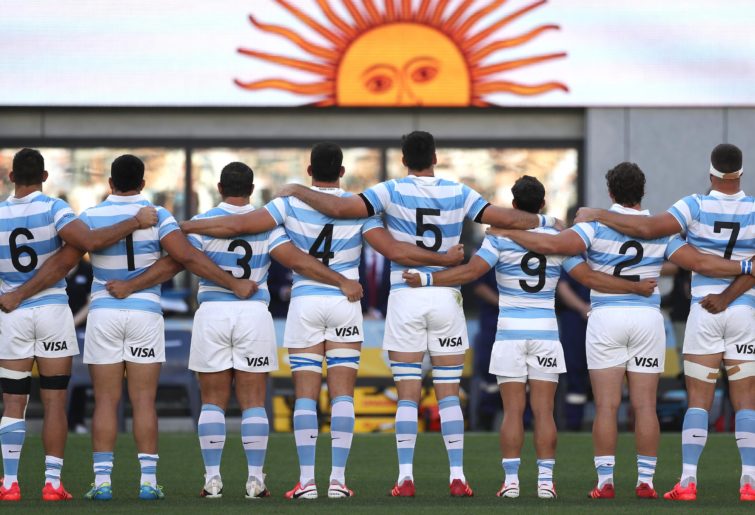
(Photo by Mark Kolbe/Getty Images)
While growth is exciting, it can also be dangerous if not done carefully. Expand too quickly and limited funds are stretched too thin to be sustained. Expand to the wrong area and a support base can’t be built, which will further drain funds from the competition to keep a sinking team afloat.
Already the Super Liga is discussing expansion in their second season or when the COVID-19 pandemic subsides, with Spain, Portugal or Mexico being mentioned as candidates. More sensibly there have also been rumours circulating about a second Chilean, Uruguayan or Brazilian franchise. While this raises an eyebrow and some interest in the league, it would be wise for SLAR to learn some hard lessons from Los Jaguares and the fall of Super Rugby.
The first lesson SLAR should learn from Super Rugby is to not be spread thin. Too many teams across too many continents make for a competition too hard to follow week-in-week-out. For their own best interest the South Americans need to stay local and forget about the possibility of Spanish, Portuguese or Mexican franchises. Adding that trio would see nine teams in nine countries. The costs associated with and the impact on player welfare of flying across time zones would only strain the league. This does not mean that SLAR should forget them entirely, but rather it should use these countries to find talent for its own teams.
The second lesson is to be wary of a conference system. In its heyday Super Rugby followed a round robin format, but as it grew there needed to be a restructuring. There couldn’t be too many games due to the international calendar and there couldn’t be too few as broadcasters need games to make money. A four-conference system was introduced at Super Rugby’s peak of 18 teams. The complexity of figuring out which conference played which and who played who was a nightmare for fans to follow, creating disinterest in the competition.
Moreover, conferences allowed for some teams to have an easier draw of games. In 2017 the Lions won 14 of 15 games without playing any teams from New Zealand until the semi-finals. For the sake of the fans, keep it simple, keep it double-round robin and steer clear of the conference system.
Sports opinion delivered daily
The third lesson Super Rugby can teach SLAR is to start in the rugby heartlands. The first Super Rugby teams were based where rugby was the strongest in Australia, New Zealand and South Africa. If SLAR wants to increase the size of their league, then place the teams where the fans and academies are.
So where would be the best place to start expansion for the South Americans? Argentina is most obvious. After all, Los Pumas have been the envy of their neighbours for decades. Compared to the rest of the continent Argentina is a big fish in a small pond. There is no shortage of players either. The majority of the other teams have a good cluster of Argentineans to support their ranks. Despite the Olimpia Lions being based in Asuncion, Paraguay, the majority of players are Argentinian.
Due to Los Pumas success internationally, the majority of fans would also be based in Argentina. Already Los Jaguares are dominant in the competition and most likely to take home the trophy. A team in Cordoba, Rosario and Tucuman would be only beneficial and help to create some local derbies that would keep fans excited. A second team based in Buenos Aires would get the hot-blooded passion of South American fans pumping.
Look at the Primera Division of football, where there are multiple Buenos Aires teams. Often these games are the most hotly contested and watched on TV. The Superclasico between Boca Juniors and River Plate is renowned in the football world as a must-watch match every year. Imagine if the Jaguares had a local rival to battle each year. There is no shortage of talent in Buenos Aires either. Eight of the 16 teams that participate in the Nacional de Clubes, the national club competition, stem from the Buenos Aires area.
More Rugby
- What South America can learn from Super Rugby
- Blow for Springboks in Rainbow Cup
- Super Rugby tipping panel Week 10: Penultimate week and whatever the one after that is called
- Super Rugby AU Round 10 teams: Force get major boost for must-win match
- Ten out of tens: What will Super Rugby Trans-Tasman deliver?
Excluding the Argentine superpower, where else should get an expansion team? For now there are only two other sensible choices.
Uruguay is the only other nation in South America that has also played at the Rugby World Cup. While Los Teros can only brag about winning three out of 15 World Cup games, a second Uruguayan team would help them to increase their developed player pool and help them to be more competitive. After all, most developed rugby nations have at least two professional clubs; Uruguay should be the same. However, this seems likely as Uruguay were touted as having two teams at SLAR’s creation.
Brazil could also have potential as a location for more teams. Brazil was originally supposed to have a second team based from Florianopolis before sensibly deciding it would be best to start with one team. The Maori All Blacks took on the Tupis in 2018 and have been competitive against teams like the USA and Canada. Not to mention that there is a market of 211 million people waiting to discover rugby in the football-mad country.
Expansion for the young league will inevitably happen, especially when there is an aim to grow rugby across the continent. For now we can only sit back, watch and hope that the Super Liga doesn’t follow the same footsteps as Super Rugby. After all, those who don’t learn from history are doomed to repeat it.
Original source: https://www.theroar.com.au/2021/04/22/what-south-america-can-learn-from-super-rugby/
https://therugbystore.com.au/what-south-america-can-learn-from-super-rugby/
Wednesday, April 21, 2021
Ten out of tens: What will Super Rugby Trans-Tasman deliver?
It is an exciting time for rugby in New Zealand and Australia.
A brand spanking new Trans-Tasman competition kicks off on May 14, with a quarantine-free air bridge underwriting it. That marks the beginning of a new era of co-operation between the two countries.
All the politicking and backbiting shed by the collapse of the old Super Rugby now seems to be just a dim memory, if the idyllic pictures of New Zealand Rugby CEO Mark Robinson and then-RA interim boss Rob Clarke walking together on Manly beach last November are to be believed.

(Photo by Cameron Spencer/Getty Images)
Super Rugby Trans-Tasman not only fills a yawning gap in the rugby calendars of both nations, it looks to offer a solid foundation for the future of the Antipodean game in the tier between provincial and Test rugby.
The recent announcement of the inclusion of two Pasifika teams in 2022 reinforces the sense that, at long last, something real and sustainable is happening in the administration of the game in the south.
When announcing the Trans-Tasman competition, Robinson was right to be delighted at the outcome.
“Super Rugby Trans-Tasman is a great result for fans on both sides of the Tasman and is testament to the strength of the relationship between New Zealand Rugby and Rugby Australia,” he said at the time.
“It has been a testing time for rugby in both countries, but also a chance to reimagine the game in our part of the world for 2021. The result is an exciting and innovative new competition, which will benefit fans, players, broadcasters and Super clubs.”
Clarke, who no longer sits in the top RA job, was similarly pleased.
“This is a truly historic day for rugby in the southern hemisphere, with the first-ever Australian and New Zealand Super Rugby competition.
“This will generate enormous excitement across both countries with some of the best players in the world set to challenge each other after the conclusion of Super Rugby AU and Super Rugby Aotearoa…
“I’d like to thank Mark Robinson and his team at New Zealand Rugby for working so closely with us. Bring on 2021!”
For Australia in particular, the existence of this stepping stone between domestic Super Rugby and international level is vital. The quality of the opposition will be consistently higher than it is in Super Rugby AU, and it will tell Dave Rennie far more about the Test-worthy aspirations of the players in his Wallabies squad. The coarse will be rapidly separated from the fine.
“We want to play the Kiwis and everyone wants to see it and we think it will bring the best out of us at all,” Queensland Reds captain James O’Connor said at last week’s Wallabies training camp.
“Everyone brings something different, like Australian rugby it’s similar styles but intricacies within that and the Kiwis are the same and I can’t wait to unlock their defence.
“We’ll watch some game footage, kick it old school, get the popcorn out and blackboard up and start writing some plays up, I’m really excited to do that.”
From this point of view, the May 22 tryst at Suncorp Stadium between the two current competition leaders, the Reds and the Crusaders, looms large in the calendar.
The Crusaders have some problems of their own. Although they still head up the Super Rugby Aotearoa table, they have lost two of their last three games and went down 25-26 to the Chiefs in Hamilton over the weekend.
Since I wrote a piece on the Chiefs at their most hapless in the middle of March, they have coincidentally won four games on the bounce to move within one game of the competition lead.
In that article and the discussion afterwards, I argued the case for moving Damian McKenzie to number ten and introducing Chase Tiatia at fullback.
The Chiefs started with that arrangement against the Crusaders, and with the added bonuses of a strong scrum and substantial contribution from the back row, the home side were able to dominate more than 60 per cent of territory and possession against the defending champions.
They made four times as many clean breaks, beat three times as many defenders, and made twice the number of offloads. The longer the game went on, the more control of the ball the Chiefs enjoyed.
With ‘D-Mac’ launching the high kicks off his right foot and Chase Tiatia booming a cannon off his left, the kicking game was in good hands:
But it was McKenzie’s ability to maintain constant pressure on the Crusaders defence with ball in hand that was the key to victory. I doubt any Australian number ten other than O’Connor, would have been able to match his level of decision-making, running and passing in the teeth of the defensive line.
McKenzie varied his positioning intelligently according to the needs of the moment. In the following example, he has noticed an opportunity to exploit the Crusaders’ baffling selection of Tom Sanders – normally a blindside flanker – on the openside of the scrum:
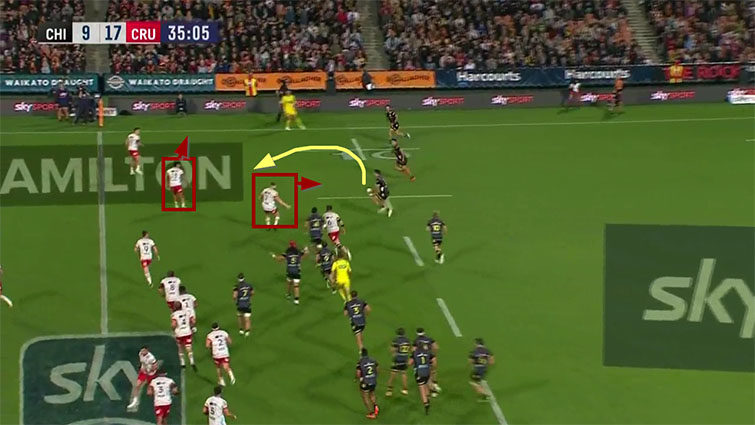
The flyhalf gives himself five metres of depth off the pass from Brad Weber, in the knowledge that Anton Lienert-Brown is the man best placed to expose the transition zone between a forward (Sanders) and a back (number 13 Leicester Fainga’anuku). Sanders is facing forwards, Fainga’anuku is already looking towards touch. The extra depth allows him to get the ball into the critical space in comfort.
On the next phase, the scenario has changed completely. Against a defence still struggling to regroup and find structure after Lienert-Brown’s long break, McKenzie attacks the line much more aggressively, looking to make an extra pass in contact and prevent the opposition from reorganising:
He delivers the offload to the Chiefs’ number eight Luke Jacobson. There was a positive connection between McKenzie and his back-row forwards – and Jacobson in particular – throughout the game:
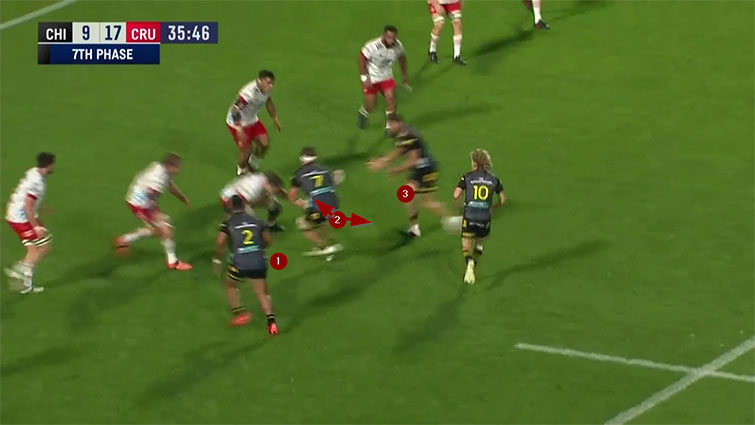
McKenzie is ghosting no more than a metre or so behind the middle man of the forward pod in front of him (number seven Lachlan Boshier), ready to take on the Crusaders forwards opposite. Bryn Gatland would probably be standing a metre or two further back.
Jacobson made a living running off flat cut-out deliveries from McKenzie:
McKenzie only fires out the pass when he sees the defenders have been forced to stop and square up on him. That cuts downs their ability to react to any late changes of angle by Jacobson.
Put it all together, and intelligent hole-running from the back-row was able to convert the opportunities created by McKenzie and Tiatia:

After a long break by Alex Nankivell, McKenzie again drops off deep when he sees a gap developing between the two Crusaders edge defenders, number 22 Dallas MacLeod and number 11 George Bridge.
McKenzie does not overplay his hand, but prompts Tiatia to do most of the work at second receiver and release Boshier through the hole. On the following phase, he is right up at the line and comes close to scoring near the right corner.
In the final example, the same structure is divided into two consecutive phases:
First McKenzie leads Tiatia through the hole with another flat cut-out pass, then Luke Jacobson is up on next phase, dropping an offload to left wing Etene Nanai-Seturo.
The pressure on the Crusaders defence never slackened. It pushed the Chiefs over the edge and into playoff contention, and it may well have projected Damian McKenzie into the All Blacks squad as a first-five.

Damian McKenzie. (Photo by Michael Bradley/Getty Images)
Summary
For once, it was Richie Mo’unga’s turn to lurk in the shadows. Inevitably he had one moment of magic, setting up a first-half try for Will Jordan. But with his forwards dominating possession of the ball, it was Damian McKenzie’s time to hog the limelight at flyhalf.
And shine he did, with the help of Chase Tiatia at fullback and a workaholic back-row in which Luke Jacobson and Lachlan Boshier were outstanding. The Crusaders were second-best in most of the areas they are accustomed to dominating – the scrum, in contact, and in game management from the primary playmaking positions.
The Chiefs are unrecognizable from the rabble that lost 16-39 to the same opponents in the reverse fixture earlier in the season, and the game will have done McKenzie’s claims to be considered at first five-eighth for the All Blacks no harm at all.
The level of performance at which players like McKenzie and Mo’unga habitually operate will set the bar for their Australian counterparts when Super Rugby Trans-Tasman (hopefully) begins in mid-May.
An ancient rivalry is about to be renewed, and it will only gain in strength in 2022 from the addition of two more Pasifika franchises. Forget the Super Rugby AU final, it’s that first long look into the eyes of the auld enemy from across the water that really matters. Drink it up, because that’s the good stuff.
Original source: https://www.theroar.com.au/2021/04/21/ten-out-of-tens-what-will-super-rugby-trans-tasman-deliver/
https://therugbystore.com.au/ten-out-of-tens-what-will-super-rugby-trans-tasman-deliver/
Eddie Jones: England coach gets RFU backing after review
Original source: http://www.bbc.co.uk/sport/rugby-union/56819737
https://therugbystore.com.au/eddie-jones-england-coach-gets-rfu-backing-after-review/
Tuesday, April 20, 2021
Why have SANZAAR remained silent on 2022 Super Rugby plans?
Though the two-way travel bubble is now officially open between Australia and New Zealand, we’re still a few weeks away from Super Rugby Trans-Tasman beginning in earnest, and to some extent this competition remains firmly in the ‘I’ll believe it when I see them running out” category.
Even just four weeks out from the first round of the competition, it feels like the prefix ‘proposed’ is still required.
There are far fewer reasons for it not to go ahead now, yet it still feels like it wouldn’t take much for it to be quickly to swept into the too-hard basket.
As we know, the proposed Super Round, originally pencilled in for Round 3 of the cross-over competition, already resides in said basket, after the game simply ran out of time to get such a mammoth event up.
But despite the fluidity that still sits around what professional rugby on either side of the Tasman looks like in just a month’s time, plans for next year are surging ahead regardless.
New Zealand Rugby took great delight last week in trumpeting its conditional approval for the addition of both Moana Pasifika and the Fijian Drua to next year’s competition.
“The NZR Board’s decision to approve licences is a major step toward the two Pasifika teams joining NZR’s existing five Super Rugby Aotearoa clubs and Rugby Australia’s (RA) five Super Rugby AU teams in a new tournament being planned for 2022 and is conditional on their final business plans and RA’s support,” the NZR statement read last Wednesday.
More Rugby
- Why have SANZAAR remained silent on 2022 Super Rugby plans?
- Get your questions in for Issue 9 of Coach's Corner
- In praise of the small men
- TJ Perenara: Why he will make it in the NRL - and why he won't
- The Wrap: Rugby’s devil is in the detail
It was news greeted with great excitement across the various media, invoking plenty of discussion on social media and online forums, including these very pages.
Even with the significant and obvious ‘conditions apply’ fine print that came with the news, it is genuinely great news to see actual movement – rather than rhetoric – around granting access to the professional level of the game for the island nations of the Pacific.
Rugby Australia followed with a cautiously worded statement later the same day, indicating they were “encouraged by the announcement today regarding the conditional approval of licences to Moana Pasifika and Fijian Drua”.
“As joint participants and administrators in the competition, Rugby Australia looks forward to understanding the outcomes of the next phase in their licence approval,” the statement continued.
The key point for me, among several key points the RA response made, was the words, “As joint participants and administrators in the competition”.
Up until this point, you could easily have assumed NZR rugby were ploughing ahead regardless with plans and announcements for a competition on unknown structure, format, and administration. It wasn’t that far removed from their brinkmanship in the very early discussions around a post-COVID return, where they boldly made room for “two to four teams from Australia” in 2021.
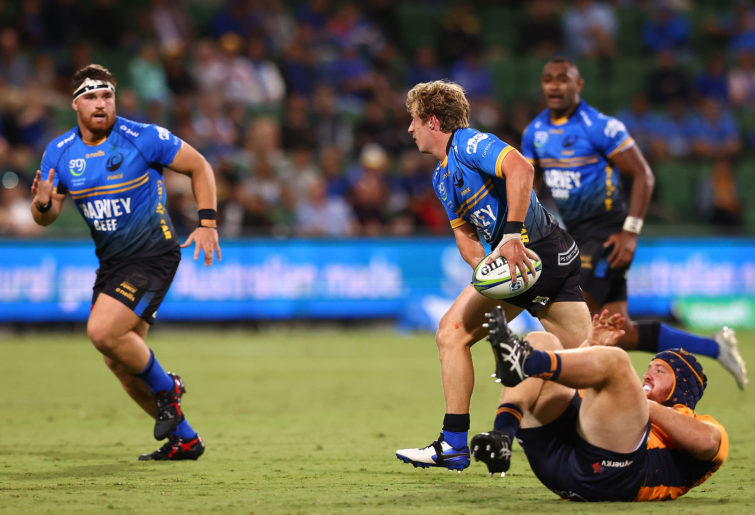
(Photo by Paul Kane/Getty Images)
But after eventually moving on from trying to work out what licences NZR were conditionally granting, my curiosity extended a bit further up the rugby tree – to the body who still, in theory, govern professional rugby in the southern hemisphere.
As more and more was being said and written and discussed about next year’s competition across the weekend, one significant question remained front of mind:
Why haven’t SANZAAR said anything about the plans for 2021?
Well, mainly because they’re not SANZAAR’s plans to say anything about, I’ve learned over the last day or two.
Whereas it had previously been explained to me that Super Rugby AU and Super Rugby Aotearoa, and even the upcoming Super Rugby Trans-Tasman remained SANZAAR competitions overseen by the joint venture governing body, this isn’t actually the case.
A SANZAAR spokesperson confirmed to me that the respective domestic competitions are owned by the national unions, and not the SANZAAR partnership; that is, the full joint venture including South Africa and Argentina.
Further, the upcoming trans-Tasman comp will be a joint venture of RA and NZR, with no oversight from SANZAAR.
SANZAAR’s role in the current competitions is more around assistance with travel and logistics management, and the judicial process. SANZAAR do announce match officials for the respective competitions each week, but the appointments are actually made by RA and NZR.
The SANZAAR joint venture owns and runs The Rugby Championship tournament, a la the Six Nations, but now does not oversee a provincial tournament within its remit.
The Super Rugby brand remains SANZAAR’s, and its attachment to the domestic comps in Australia and New Zealand makes perfect sense, as it did with Super Rugby Unlocked in South Africa late last year. Whether the Super Rugby name remains in place next year, and how that competition is governed remains a decision for RA and NZR.
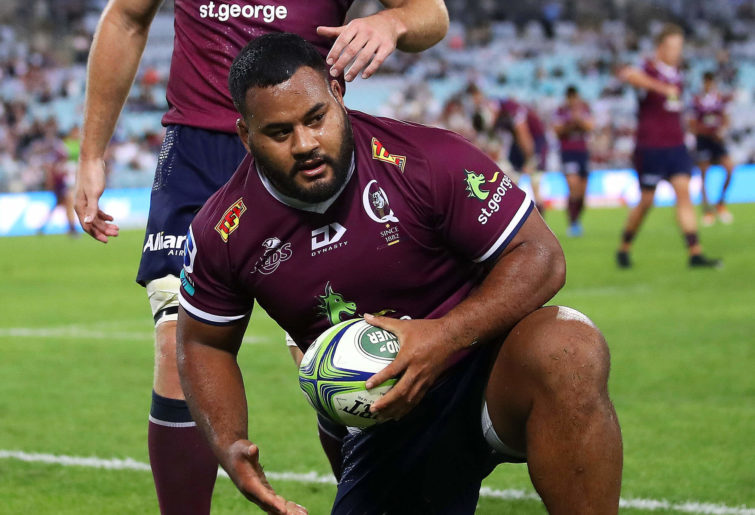
Taniela Tupou. (Photo by Mark Kolbe/Getty Images)
So, what of Rugby Australia?
Their involvement so far has – by design – been to let NZR run whatever process they feel needs to be run, but comfortable into the knowledge they will still be able to make the best decision for Australian rugby.
Reporting over the weekend confirms this, as does last week’s statement: “Rugby Australia is excited about the growth of Rugby in the Pacific and is committed to exploring future opportunities in the region, in conjunction with the continued sustainability and success of Australian Rugby and its Super Rugby teams.”
My understanding is conversations between Australia and the Fijian Rugby Union have been going on for months, and that discussions about the Drua entering Super Rugby were firmly on the table, even if it just meant the Australian edition again. Australian rugby has reasonable runs on the board regarding assisting the game in Fiji, but there’s also no denying three games a weekend is better than two.
Equally, and logically, six games a weekend is also much better than four.
It’s my understanding that RA have given themselves a timeframe of the next few months to conduct their own due diligence on the bids, and to make sure they are confident both teams will be ready to go in 2022. Paul Cully for Stuff.co.nz wrote of this too, that delaying to 2023 could be an option “if (RA) feel the process has been rushed or would compromise the launch of the new competition in 2022.”
That said, if the bids do stack up for RA, then the next step in the process would be to enter discussions with NZR around competition format (e.g., a round robin or conferences), and how the competition is running. Again, both RA and NZR have raised the topic of a commission style governance.
It’s all really encouraging.
No doubt, the news around Moana Pasifika and the Fijian Drua edging one step closer to the professional game is wonderful, and is rightly being celebrated for being the wonderful opportunity that it presents.
And I say that even with all of the obvious and complicated questions that remain. Lots of very important details still need to be worked out, even once further approvals are given and Rugby Australia provides its own rubber stamp on the process.
Clearly, there’s a lot of boxes to tick. But it certainly feels like there is enough good will on all sides of the 2022 plans to get it done.
Original source: https://www.theroar.com.au/2021/04/20/why-have-sanzaar-remained-silent-on-2022-super-rugby-plans/
https://therugbystore.com.au/why-have-sanzaar-remained-silent-on-2022-super-rugby-plans/